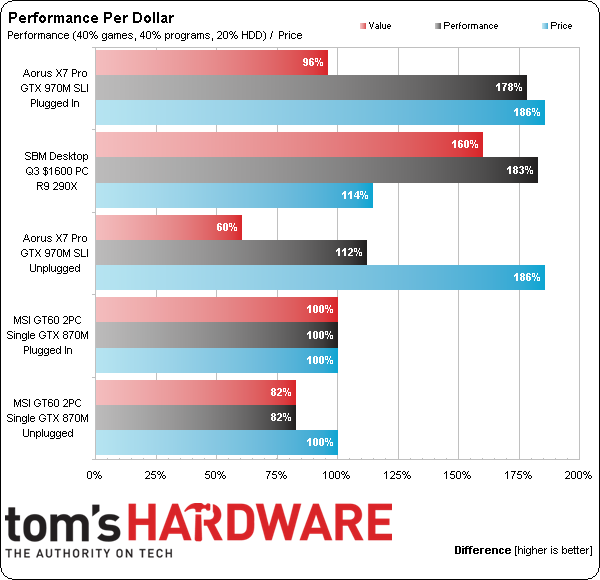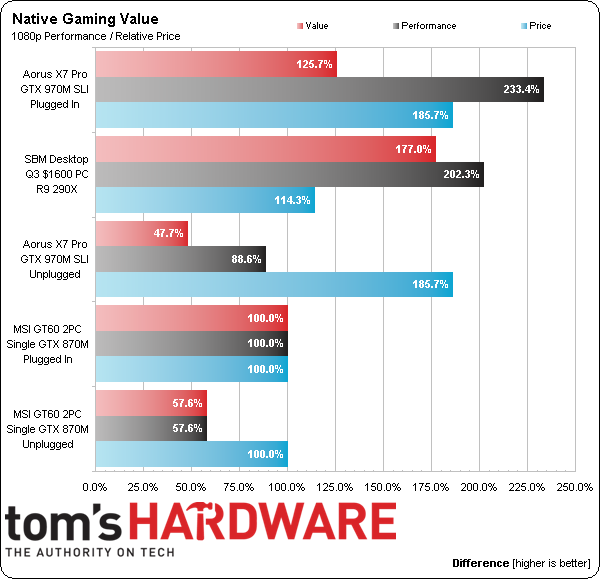Aorus X7 Pro Notebook Review: GeForce GTX 970M Gets Slim In SLI
Combining the power of two GeForce GTX 970M GPU in a compact chassis, Aorus enables the mobile market with incredible graphics potential. Can its X7 Pro really live up to the firm’s claims of desktop-class performance?
Aorus X7 Pro: Performance, Efficiency And Value. Pick Two.
Aorus tells us that its X7 Pro, as delivered, will cost $2599. If we treat it as a general-purpose portable PC, that puts it on par with last spring’s GeForce GTX 870M configuration.
On the other hand, the X7 Pro’s primary mission is to play games while plugged in to the wall. Pick it up, take it to the office, plug it in. Go to a LAN party, plug it in again. When we treat it as a transportable gaming machine, it looks like an even better value.
It even beats a $1600 desktop machine in measures of raw performance. The price penalty for portability is around 50%, though my desktop build would probably need the added performance and cost of a desktop-oriented GeForce GTX 980 to confirm that estimate.
Aorus uses slimness to drive home its message about portability, but hasn’t exactly made this one a lightweight. The X7 Pro is a nice replacement for the previously-tested Dominator series from MSI though, except that the display connector arrangement is a bit weird (requiring the use of VGA for three-display spanning). And I’m a little disappointed that the battery is so hard to replace, even though we rarely need to swap out power supplies in our mobile platforms.
I recorded an acoustic reading of 51dB(A) during my game tests from ½ meter. That’s the equivalent of 45dB(A) at 1m, the familiar distance for testing things like industrial fans and loudspeakers.
That means the X7 Pro is still an award contender, though not necessarily as a slim gaming notebook. Thanks to nagging issues like the need to manually disable SLI in order to enable BatteryBoost, I can’t recommend it to anyone who wants to game from both the battery and a wall outlet until Nvidia irons out those idiosyncrasies. It does make a really nice desktop replacement notebook though, where an 8.7-pound combined weight (with power adapter) and sub-1” thickness make the system easier to carry around in a class where portability is normally an afterthought.
Get Tom's Hardware's best news and in-depth reviews, straight to your inbox.
Current page: Aorus X7 Pro: Performance, Efficiency And Value. Pick Two.
Prev Page Power, Battery Life And Efficiency-
Nuckles_56 A nice machine but I wouldn't consider buying one til Nvidia fixes up the issues that the machine is having with SLIReply -
blackmagnum Boo SLI. You create more miserly than happiness. Do yourself a favor and buy a top single-gpu gaming notebook instead.Reply -
StarBound I'm assuming the screen is a 60hz making the SLI somewhat pointless. Still the machine is impressive but at the end of the day I cannot see myself getting something that lasts only 40min when performing its primary function (in this case gaming).Reply -
Steveymoo Colour me impressed. This could be the first truly functional gaming desktop replacement! It's faster than my desktop, and my GPU is less than a year old. Wowzers. And such a slim package.Reply -
AndrewBrodie Does the HDMI Port support HDMI 2.0? I would like to use it with a 4K TV and hope to exceed 30 FPS.Reply -
xyster FYI: Nvidia GeForce GTX 980M is offered also in 8GB capacities; not just 4gb. ie: MSI Dominator versions have it.Reply -
npyrhone The performance figures are really impressive, but why on earth are the "idle" and "reading" power consumption levels so absurdly high?Reply
I mean, I can somehow even understand the zombie drain by the other gpu, but even so: how is it possible that if you just write a word document and read news from the internet, you get something like 2h of battery life.
Obviously, the person who purchases this might not need even 1h battery life ever, but that does not change the fact that something seems to be wrong here, or even broken, when the previous gen laptop achieves 5-6h of battery life in such scenarios.
I am like 95% sure that either the power saving options were not enabled, or they were not functioning properly or some component was flawed or some driver was misbehaving. Or then something else weird was going on.
In any case, I am 100% certain that I can get 3-4h of battery life in a light use, non-gaming scenario with a properly built laptop even if it was sporting this kind of hardware (ie. i7-4870HQ, 970M SLI, 17,3" FHD...)
-
sportfreak23 Was thinking of purchasing this to replace my current Sony Vaio S as the dual core is starting to show its age. But the 1080p screen is kinda turn off when aorus offers a high res screen on its X3. Wish they made a high res 980M sli option to be purchased as this current 970m setup doesn't impress me much.Reply -
hst101rox On page 4, it is not just the Aorus x7 pro that has an AC adapter with an efficiency rating of "V", but the Delta 180W of the MSI GT60/70 and most any other new laptop, and tablet/smart phone charger should also be at that efficiency rating.Reply


